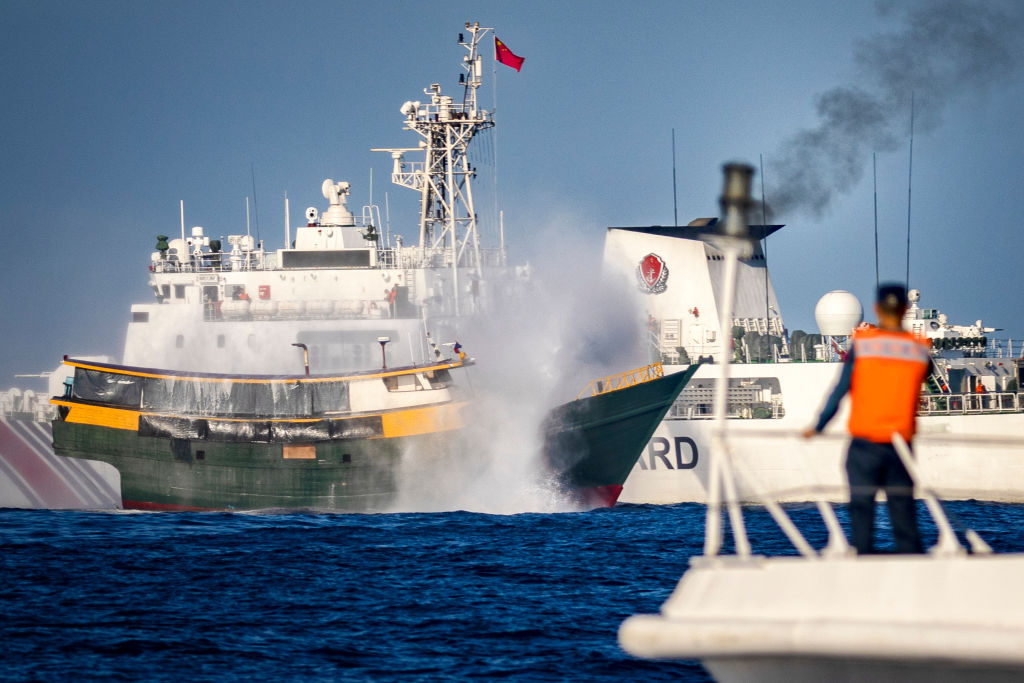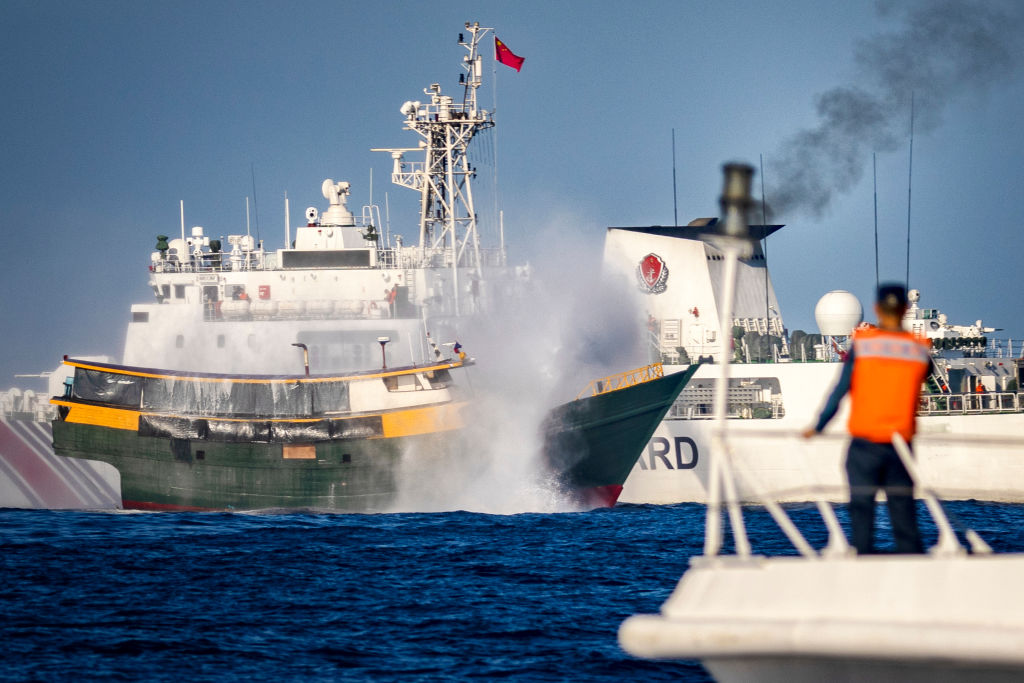

For years, China has been testing the limits of its aggression in the South China Sea to see how much it can push before someone, meaningfully, pushes back. It’s a dangerous game that recently left three Philippine Navy personnel injured after their resupply ship to the Second Thomas Shoal—an atoll at the center of disputes over rival territorial claims of the all-important waterway through which a third of the world’s trade passes—was surrounded and fired upon with a water cannon by Chinese coast guard and militia vessels.
In video of the March 23 incident, crew members could be heard shouting as jets of water pummeled the Philippine ship, which sustained heavy damage.
It’s not the first such attack by Chinese forces on Philippine sailors, nor is it likely to be the last. But looming over the increasingly confrontational encounters between the two nations is the potential of future U.S. military involvement. A mutual defense treaty between Washington and Manila necessitates one to come to the support of the other in the case of an “armed attack”—though it remains unclear what exactly would constitute such. “Responding to coercive actions in the ‘grey zone’ is difficult precisely because the lines between peace and conflict are blurred,” says Veerle Nouwens, executive director for Asia at the International Institute for Strategic Studies.
So far, China’s actions have only elicited sharp diplomatic protests. After the weekend incident, the Philippines summoned a Chinese diplomat to condemn “the aggressive actions by the China Coast Guard,” while the U.S. State Department reaffirmed its support for the Southeast Asian country, with a spokesperson saying China’s actions “are destabilizing to the region and show clear disregard for international law.” China’s defense ministry, meanwhile, called the Philippines a provocateur, warning that it should “cease making any statements that may escalate tensions and stop all acts of encroachment.”
Whether the war of words could one-day morph into an actual war, however, analysts say, is dependent on a number of competing considerations.
Chang Jun Yan, head of the military studies program at the S. Rajaratnam School of International Studies (RSIS) in Singapore, tells TIME that there are three “important variables” the U.S. must prioritize: deterrence against China, reassurance to the Philippines, and diplomacy towards China. “The U.S. cannot afford to abandon any of these three things,” he says.
There’s also a fourth factor at play, says Joseph Liow, a professor of comparative and international politics and dean at Singapore’s Nanyang Technological University (NTU): U.S. domestic politics. “If a conflict does break out in the South China Sea, how is the administration in power in Washington going to explain to its people that it is in their interest that the U.S. get involved in a conflagration—and in the process, risk going to war with China—over a bunch of rocks thousands of miles away?” U.S. resources are already stretched thin by conflicts in Ukraine and Gaza—and there’s dissatisfaction among many Americans over U.S. involvement in both those crises.
Read More: The War in Gaza Is a Test of U.S. Power
It leaves the U.S. in a difficult position of weighing whether or not to intervene as it watches with interest the ongoing, growing spats in the South China Sea. In short, says Colin Koh, a senior fellow at RSIS, the U.S. has to “draw a balance between doing nothing and doing too much.”
Allowing Beijing’s aggression against the Philippines to continue unchecked would be detrimental to U.S. interests, says Kevin Chen, associate research fellow at RSIS. Chen tells TIME that the U.S. risks losing “trade routes through the South China Sea, its standing as a security partner, and its access to bases in the Philippines, which would be invaluable in the event of a Taiwan contingency,” should it leave the Philippines to fend for itself. “Faced with Beijing’s assertiveness, the stakes are not only high for Manila, but for Washington’s credibility and defense strategy in the region as well.”
For its part, the Philippines has taken a diplomatic approach to calling for the U.S. to get involved. Last year, President Ferdinand Marcos said the existing mutual defense treaty needed to be adjusted amid the South China Sea conflict and other regional threats. “The situation is heating up,” he said, calling for clarity on the U.S.’s commitment. But speaking to Bloomberg last week, Marcos said that, while the U.S. has been “very supportive,” the Philippines can’t fully rely on its ally should a crisis erupt: “It is dangerous for one to think in terms of when something goes wrong, we’ll run to big brother.”
There are also clear risks to the U.S. intervening. “Obviously, relations with China have been difficult for the last few years,” says NTU’s Liow. “An outbreak of hostilities between these two great powers will be very dangerous,” he adds. “It is not in the interest of the U.S. to come to blows with China or vice-versa.”
The U.S. has tried in recent years to reduce its tensions with China, with President Joe Biden saying during his recent State of the Union address that he seeks “competition, not conflict.” And it’s “a thaw, importantly, whose consolidation America’s friends in the region support,” says Ali Wyne, senior U.S.-China research and advocacy advisor at the conflict resolution think tank International Crisis Group (ICG). The Indo-Pacific, where the U.S. has increasingly sought to make diplomatic inroads, includes nations with close relations with China, like Cambodia and Myanmar, as well as ones that adhere to political neutrality in the great-power rivalry, like Indonesia and Singapore.
“Regional states do not want to see war break out between the U.S. and China,” says Chang. “Ultimately, the use of force in the South China Sea will benefit no one.”
That doesn’t mean the U.S. is doing nothing. “U.S. commitment clearly goes beyond rhetoric,” says Chang, pointing to imposing sanctions, bolstering allies’ military capabilities, fostering economic partnerships, and supporting freedom of navigation rules in the region as indirect mechanisms of intervention.
The U.S. will likely continue, says ICG’s Wyne, to “impress upon China that an armed confrontation with the United States would carry severe security, economic, and diplomatic risks.” RSIS’s Chen says this will primarily take the form of “rhetorical support”—in other words, more statements. “We should also see more efforts by the U.S. to facilitate cooperation between third parties,” he says, “such as the upcoming U.S.-Japan-Philippines trilateral summit in April, as well as more joint patrols as a tangible reminder of U.S. defense support.”
RSIS’s Koh tells TIME: “We have to be realistic about what those current U.S. actions are, what they are designed for, what they are supposed to accomplish.” It’s “too much,” he says, to expect the U.S. to stop Chinese aggression. Rather, it appears the U.S. is seeking to contain it—and on that, the U.S. has actually been relatively successful, so far. “Because if you don’t contain, then there’s a likelihood that the Chinese get bolder and thereby they escalate even further.” What the U.S. has been doing is “drawing a line for China, not to cross.”
Of course, the U.S. could change its tune if that line does get crossed. “There are still possibilities for a sudden, sharp escalation,” says Chen. “Given the physical encounters at sea, it may not take long for an incident that causes Philippine fatalities. At that point, Washington would have to reassess its policies in deference to how Manila wants to move forward.”
An attack that results in a death would arguably leave the U.S. with no choice. “If the U.S. does not eventually back its allies when it said that it would,” says Liow, “the damage to American credibility and leadership will be consequential, perhaps even irreparable.”
EMEA Tribune is not involved in this news article, it is taken from our partners and or from the News Agencies. Copyright and Credit go to the News Agencies, email [email protected] Follow our WhatsApp verified Channel









